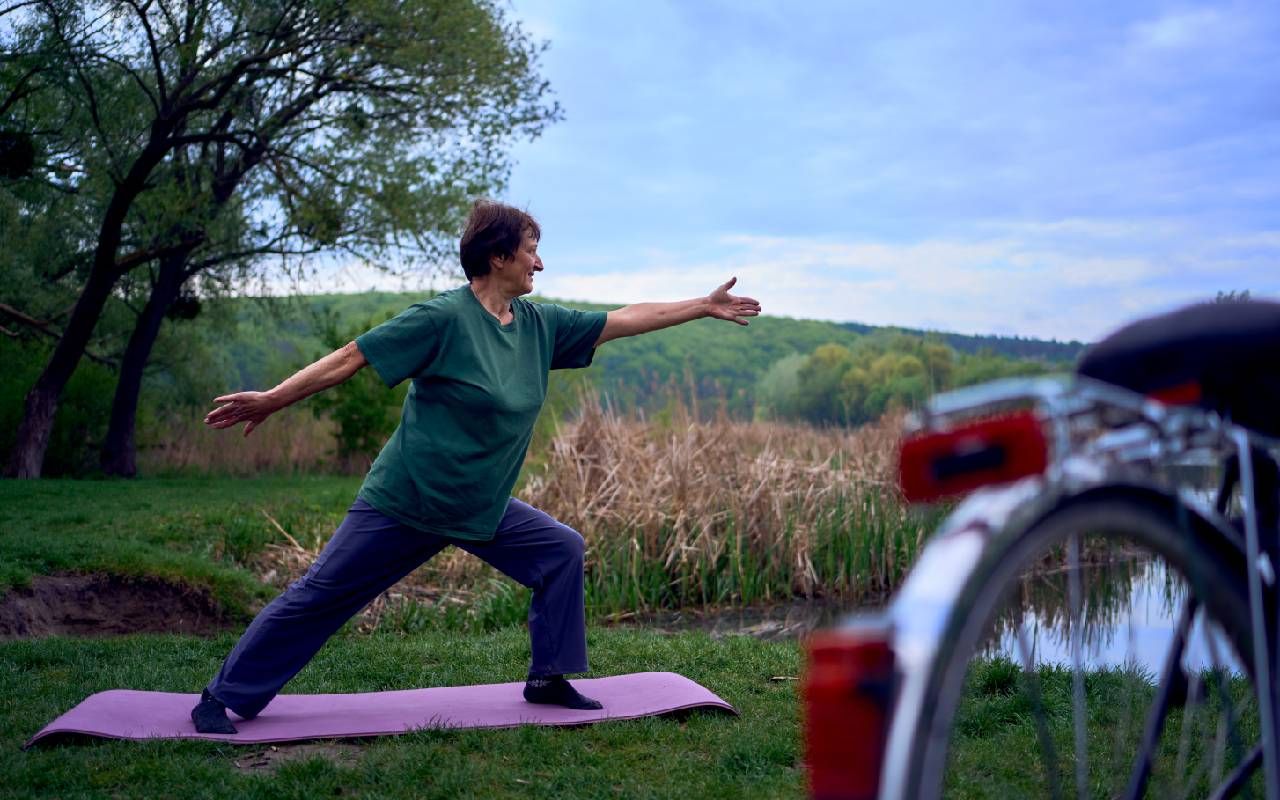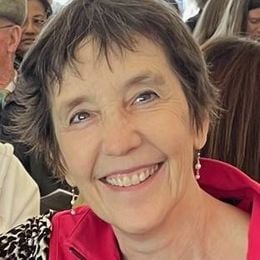Yoga for Osteoporosis: 20 Minutes, 12 Poses
After my own osteoporosis diagnosis, gathering information led me to the centuries-old practice of yoga
When I was diagnosed with osteoporosis in November 2022, my nurse-practitioner handed me a prescription for Fosomax (the same drug my late mother had used) and a nine-page printout from Mayo Clinic. It provided an overview of the disease — its symptoms and causes — and outlined steps I could take to improve my bone density, or at least prevent further weakening of the bones.

I soon became familiar with the frightening facts. Given that I am female, white, post-menopausal and thin, as well as having a mother afflicted with the disease, I was at increased risk for osteoporosis and its precursor, the less serious osteopenia.
Gender is the key risk factor: More than 80% of the 10 million people in the United States with osteoporosis are women.
Gender is the key risk factor: More than 80% of the 10 million people in the United States with osteoporosis are women, according to the federal government's Office on Women's Health. Untreated, osteoporosis can result in fractures of the hip and spine, increased risk of falls, loss of height and a stooped upper back, known colloquially as "dowager's hump" — a term that the Cleveland Clinic still uses.
Medication is often prescribed and, in my case, was barely discussed. When I asked about alternatives to Fosomax (the brand name for Alendronate), my nurse-practitioner urged me to try it "for five years" and to remain standing or sitting upright for 30 to 60 minutes after swallowing the weekly pill on an empty stomach.
Side effects can include an upset stomach, thigh-bone fractures, leg cramps, esophageal issues and, in extreme cases, a deterioration of the jawbone called osteonecrosis. But my health care professional told me none of that.
Like everything I have learned about osteoporosis in the 18 months since my diagnosis, I have gathered this information on my own. To my surprise, the path of inquiry toward safer movement and healthier bones has led me away from Western medicine and toward the intuitive, centuries-old practice of yoga.
Hug the Muscles to the Bones
Nearly a decade ago, New York Times "Personal Health" columnist Jane Brody (now retired), wrote a blog post about a years-long study trying to prove that yoga could improve bone density. The researcher was Dr. Loren M. Fishman, a physiatrist in New York City and longtime practitioner of Iyengar yoga, which emphasizes alignment, use of props such as blocks and straps, and holding poses for longer periods than a typical "flow" class.
Fishman, an assistant clinical professor at Columbia Medical School, did a pilot study of 10 yoga postures with 117 people and published his results in 2009. Compliance was poor, but he was heartened by the people whose bone density did improve.
"The control group lost bone mass," he explained in a recent interview from his Manhattan office. But the people who took his special yoga class once a week and practiced at least four more times weekly saw increased bone density in their hips — one of the key places, along with the spine, where osteoporosis presents itself.
What differentiates this practice of familiar poses is the intensity, endurance and muscular engagement.
That initial pilot led to a more sophisticated follow-up study using a different sequence of poses — five standing, seven on the ground — that would be familiar to any yoga practitioner, including Tree Pose, Warrior II, Revolved Triangle and Bridge. Available on YouTube as 12 Poses vs. Osteoporosis, they specifically target the hips, femur (or thigh bone) and spine.
Fishman, now 83, has since created Series 2 and Series 3, incorporating 24 additional poses, some aimed at strengthening the wrists — another common fracture point for people with osteoporosis. He wanted to offer students variety, so they would stick with the practice. "People get bored," he says, and mindful concentration is key for this bone-focused regimen.
Impact of Muscle Engagement
What differentiates this practice of familiar poses is the intensity, endurance and muscular engagement. "You teach it unlike other yoga classes," says Ellen Richter-Norgel, one of only two yoga teachers in Minnesota (and one of 337 internationally) who is certified to teach Fishman's method of Yoga for Bone Health. "You hold the postures differently," she explains. "What I gained from certification is the nuances and how important the queuing is for the bone-health density."
For the best effect, Fishman recommends holding each pose for at least 40 seconds — "hugging muscles to the bones," as Richter-Norgel likes to say. Fishman's second, more extensive study, published in 2016, showed bone density improvement among "compliant" patients — those who practiced daily or every other day — in the lumbar spine and thigh bones.
The idea is to build back bone density by adding stress. Though weightlifting often is recommended for people with osteopenia or osteoporosis, Fishman says that yoga rarely is understood as a weight-bearing exercise as well.
"By pitting one group of muscles against another, yoga exposes bones to greater forces and, therefore, might enhance bone mineral density [BMD] more than other means," Fishman wrote in the conclusion of his second study, published in the journal "Topics in Geriatric Rehabilitation."
Yoga is "a positive stress," says Rob Glick, senior director of programming innovation at Life Time Fitness in Irvine, California. He notes that the more common understanding of stress — overwork, multitasking, perpetual busy-ness — "is a big robber of our deep nutrients and minerals," which also weakens bones.
"It's 20 minutes a day ... "Who can't find time for that?"
People who have been diagnosed with osteopenia or osteoporosis won't see yoga's bone-strengthening effects solely from a weekly class like Richter-Norgel's Yoga for Bone Health at the Minnesota Jewish Community Center in St. Paul.
"Four times a week or more is the committed student," she explains. They're the people who "take these cues that they've embodied" from the weekly class and incorporate them into their own workouts at home.
"It's 20 minutes a day," says Richter-Norgel, who refused to take medication when her osteopenia was diagnosed. "Who can't find time for that?"
Practicing the Postures and More
My older sister discovered the "12 Poses for Osteoporosis" videos that are all over YouTube (none vetted by Fishman) three months after my diagnosis. After some trial and error, I have been practicing the two versions by Kendra Fitzpatrick three to four times a week for more than a year. Taking Richter-Norgel's weekly class since late March has taught me how to vary and intensify my home practice.
I am not due for another bone density test — known as a DEXA scan — until November 2024. But I have noticed since biking season last spring and summer that my hips are stronger from this deeper yoga practice, and the lower left side of my back (the lumbar spine, where my osteoporosis was diagnosed) rarely aches anymore.
Kelly Fisher, owner of Yoga Center of Columbia in Maryland, will be hosting a workshop with Fishman this summer and is certified in his method. At 54, she has osteoporosis "as a secondary condition" from an overactive thyroid, and says the diagnosis "shakes your confidence," which I also found to be true.
Fisher practices the original 12 poses more than Series 2 and 3. "Knowing that these have been studied and proven to improve bone density helped restore my confidence in my ability to move," she says. New medications continue to be produced and tested, but she didn't want to risk unproven products. "I wanted to heal myself through yoga."
"Knowing that these have been studied and proven to improve bone density helped restore my confidence in my ability to move."
Fishman founded Manhattan Physical Medicine & Rehabilitation as a place to combine his Western medical training with his deep love of Eastern traditions. Back in the 1970s he studied in India for a year with B.K.S. Iyengar, founder of the Iyengar style of yoga, and told me that was where he first got "an image, a vision" that yoga might work for people with osteoporosis. "It puts tremendous pressure on the bones," he says.
A book he co-wrote with Ellen Saltonstall in 2010, "Yoga for Osteoporosis: The Complete Guide," lays out 12 suggestions that Richter-Norgel hands out in her class. Those include checking first with a physician, start slowly and practice consistently but also, in all cases, to avoid forward folds, which I find to be common in yoga classes — including those for older populations.
"Forward folds are bad," Fishman told me. "They focus too much pressure on the place where most bones break. All the osteo fractures are at the front of the bone. If you do a forward bend, you're putting more pressure on the vertebrae."
I transferred to Herself Health, a primary-care clinic for women 65 and older, after my osteoporosis diagnosis. My nurse-practitioner urged me to keep taking Fosomax, calcium and Vitamin D supplements; to eat prunes because they "may" affect bone density; and to continue weightlifting and yoga.
For Richter-Norgel, who is certified at the 1,000-hour level through Kripalu School of Yoga in Massachusetts, yoga is the best prescription she could receive.
"I don't ever want to go the route of medications," she says. "There's a tool out there that I love. This is a beautiful marriage between continuing to practice yoga and increasing my bone density through Dr. Fishman's method."


